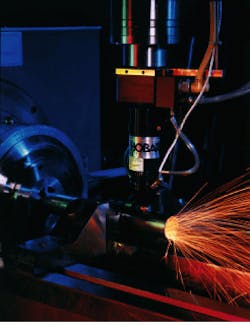End effector keeps industrial laser beam in focus
DAVID FILGAS
The combination of high-power, fiber-delivered Nd:YAG lasers and articulated-arm robots can provide a simple, cost-effective solution for three-dimensional (3-D) cutting applications. Continuous-wave Nd:YAG systems with output powers as high as 3000 W are now commercially available. The automotive industry currently uses thousands of robots with proven reliability. However, the combination of these two technologies has yet to be widely accepted. The recent introduction of autofocus end effectors for robotic cutting applications may increase the popularity of robotic laser systems.
Maintaining proper beam focus at the workpiece surface is the biggest performance issue in laser-cutting operations. Beam focus is simple to control when the parts are flat metal sheets, but it is far more difficult if the robot-controlled beam is cutting 3-D, stamped sheet metal. Such applications require active control of focal position.
A capacitive height-sensing delivery tip on the laser-focusing assembly is one way to control focal position for both flat-sheet and 3-D cutting. In these devices, special processing electronics measure the capacitance between the delivery tip and the workpiece, which varies as a function of distance. This signal provides feedback that directs motion systems to adjust the position of the robot arm, maintaining it at optimum height.
This approach is sufficient for systems with slow cutting speeds and laser powers less than 200 W. High-power systems cut at speeds up to 20 m/min, so conventional capacitive height-sensor/ robot arm-adjustment systems cannot maintain proper focus. System adjustment capabilities are limited by inertia; the mass of a robot arm is simply too large for it to make small, precise corrections while traveling at high speed.
Autofocus end effector alternative
To overcome this obstacle, manufacturers have introduced high-speed autofocus end effectors specifically designed for robotic cutting applications. These devices allow vertical adjustment of the beam-delivery unit independent of the robot arm, circumventing the issue of inertia. The signal from the capacitive height-sensing delivery tip is fed back to a servomotor controlling the end effector, which adjusts the tip standoff to maintain constant focal position.
Raleigh Industries of Canada Ltd. (Waterloo, Quebec, Canada) uses a robotic 750-W Nd:YAG laser-cutting system (Hobart Laser Products, Livermore, CA) to produce frame sections for its 156 line of youth and adult bicycles. The laser operates at 1064 nm and is mounted on a five-axis articulated robot with a two-axis trepanning head. An additional coordinated axis in the robotic system rotates the tube during the cutting process. The Hobart High-Speed Z End Effector maintains optimum delivery tip-to-workpiece standoff in the direction normal to the cut surface. The company currently offers the end effector only as an accessory to its Nd:YAG industrial-laser systems.
The laser production station at Raleigh performs complex cuts on various gauges of mild steel and Chromalloy tubes for tube-to-tube joints. The tube ends are cut in curved or scalloped shapes to provide good weld fittings; these shapes are difficult to achieve with conventional cutting systems. The machine currently produces parts for 1600 bicycle frames per day. Tubes in a loading hopper are fed singly into the laser-cutting cell. An indexer in the cutting cell grabs a tube as it enters and pushes it out to the programmed length (from 0 to 36 in.) required for a particular bicycle size, and a cut is made. When the bicycle style or size under production is changed, only the collar on the indexer must be adjusted manually. All other changes are accomplished by alterations in the robot programming.
The 750-W laser beam is delivered to the cutting cell by optical fiber. When the beam is coupled out of the fiber, it is collimated by stationary fused-silica optics. The position of a separate movable focusing system is controlled by the end effector, resulting in a tightly focused, intense beam at the workpiece surface. Oxygen assist gas enhances oxidation during cutting operations. The gas is delivered through a 1.27-mm-diameter nozzle at a pressure of about 20 psi. The nozzle is concentric with the beam-delivery optics so that the gas flow is coaxial with the beam.
The end effector is an electronic analog device that runs independently of the robot control software. Even with a small drive motor, the lightweight (300 g) effector can make rapid corrections. Within a travel range of ~7 mm, the device reaches speeds of 100 mm/s and peak accelerations of more than 2 g. The travel range is more than sufficient to accommodate part-to-part variability. In situations requiring even greater adjustments, an error signal sent to the hardware permits the robot to make gross corrections while the end effector does the fine tuning.
Benefits of the approach
Autofocus end effectors reduce the time required for programming changes. Because the devices free the robot of the responsibility of maintaining focal position, the points on the robot path do not have to be finely tuned for standoff position.
Prior to using the laser-cutting system, the bicycle tubes were cut with milling machines and punch presses that were labor-intensive, dulled quickly, and did not allow sufficient operator control for precision cuts. Production-line changeover to another bicycle style required costly downtime and separate tooling. "With robotic laser cutting," says Jim Wilkinson, industrial engineering manager for Raleigh's Waterloo plant, Owe manually load the tubes into the feeder bin and then transfer the finished tubes to the welding area. The laser-cutting program handles everything in-between."
Robotic laser cutting at the Waterloo plant has reduced a five-step manual cutting process to two steps, simultaneously achieving cleaner cuts, more consistent parts, and reduced labor.
